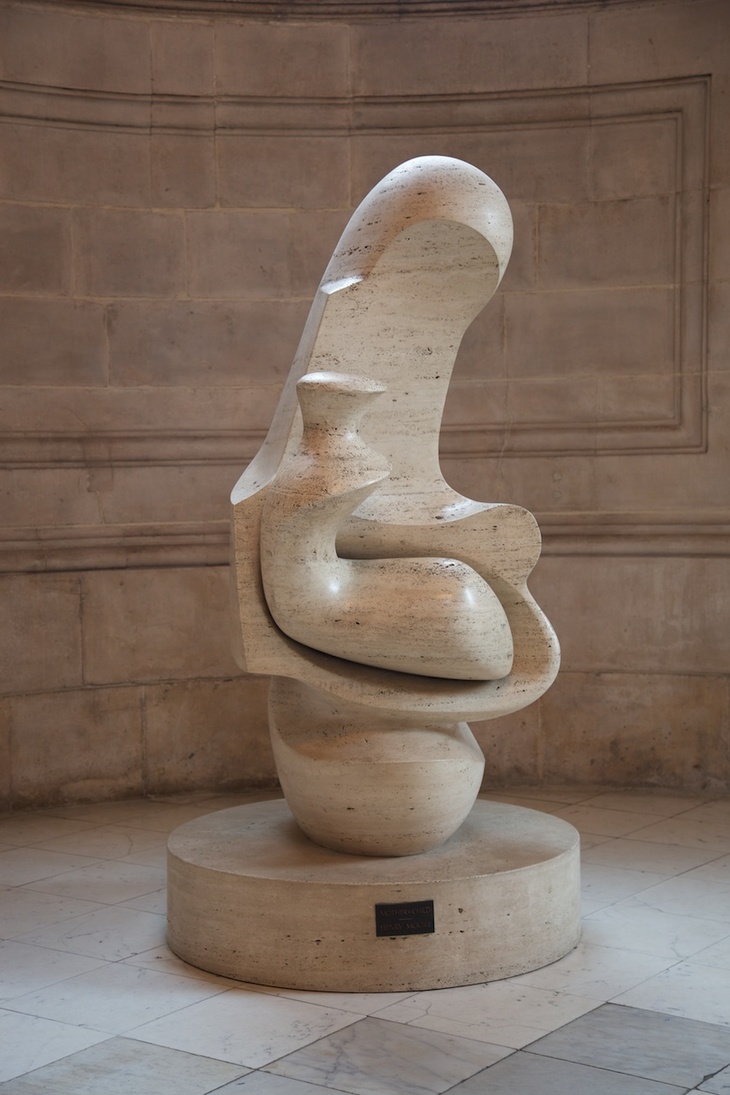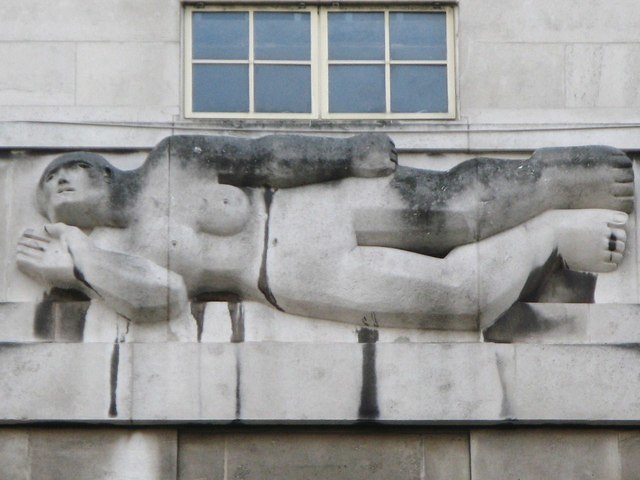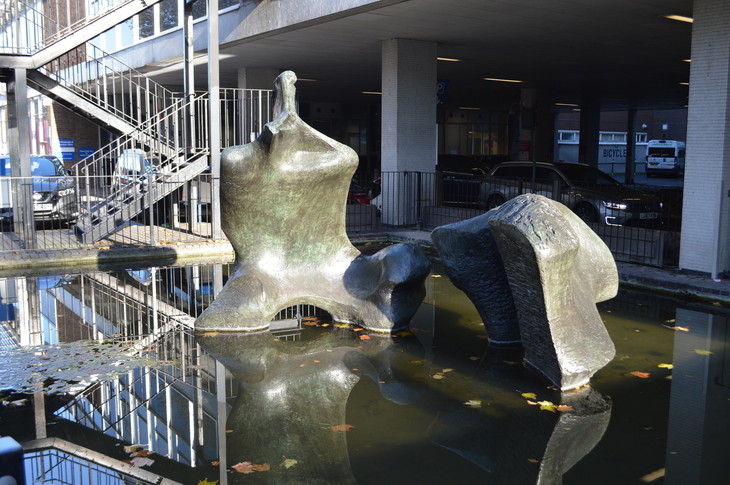
What do St Paul's Cathedral, a Kennington council estate, and the former Transport for London headquarters have in common? They're all home to work by one of the greatest English artists of the 20th century, modernist sculptor Henry Moore.
Moore is perhaps best known for his enormous bronzes, on display in public spaces all over the world. You can find plenty of those here in London, including several iterations of his famous two-piece reclining figures. But the capital is also home to a few Moore masterpieces that are easier to miss, including a church altar, a marble madonna, and a stone carving depicting the west wind.
Here's the low-down on where to find these pieces, and every other sculpture by Moore currently on display in London.
The Arch - Kensington Gardens

Let's start with an easy one. This six-metre-high, 37-ton behemoth is hard to miss during when strolling along the Long Water. Moore gifted The Arch — which is crafted from Italian-sourced travertine — to Kensington Gardens back in 1980. It stayed here for 16 years before it was dismantled due to structural issues. Happily, the piece was restored to its former glory back in 2012, and has remained in the Royal Park ever since.
Circular Altar - St Stephen Walbrook (City of London)

This striking stone altar is just one of St Stephan Walbrook's claims to fame. The Grade I listed church was designed by the great Christopher Wren, it survived the blitz, and it's the birthplace of the Samaritans charity, which was founded by church rector Dr Chad Varah.
Moore created his Circular Altar for St Stephen Walbrook in 1987 as part of a major restoration programme. Another of his works can be found outside in the churchyard; Working Model for Sundial was gifted to the church by Lord Palumbo in memory of his late wife, Denia.
Draped Seated Woman, 1957-1858 - Cabot Place, Canary Wharf

Moore made seven casts of his Draped Seated Woman 1957-1958, two of which you can find in London. One is currently on loan to Tate Britain (more on that gallery later), the other sits in Canary Wharf's Cabot Place.
The bronze was originally purchased by London County Council in 1962 for the Stifford Estate and, following the tower block's demolition, it spent over a decade on loan to Yorkshire Sculpture Park. During this time, Tower Hamlets Council controversially decided to sell the sculpture but thanks to a public campaign it was saved and returned to London in 2017.
Head - 2 Willow Road

You'll find this abstract elm-and-string visage inside one of the UK's most important modernist buildings. Architect Ernest Goldfinger designed 2 Willow House in Hampstead (the same neighbourhood in which Moore lived) and it became his family home. Today, it's run by the National Trust and you can visit it for yourself. Look out for paintings by Max Ernst and Bridget Riley while you're there.
Knife Edge Two Piece - College Green, Westminster

One of Moore's earliest two-piece sculptures sits in the shadow of Westminster Abbey. Knife Edge Two Piece is inspired by the shape of bone fragment and was donated by Moore in 1967. Two identical bronze casts are located in Vancouver and New York, respectively.
Large Standing Figure Knife Edge - Greenwich Park

Here's another anatomically-inspired work by Moore. Standing Figure: Knife Edge is loosely based on the shape of a bird's breastbone and was originally placed in Greenwich Park back in 1979. It stayed there until 2007, when the Henry Moore Foundation took it on tour. It eventually returned to the south London beauty spot in 2011.
Locking Piece - Thames Embankment, Millbank

This twisty two-piece has sat on the Thames Embankment since 1968 and is one of Moore's most famous works. The late sculptor cited multiple inspirations for this piece, including skeletal structures and a pair of interlocking pebbles found in his garden.
Multiple pieces at Tate Britain

Tate Britain has not one but two whole rooms dedicated to Henry Moore. Here you'll find large-scale sculptures including the one pictured above, plus drawings, photographs and films that provide fascinating insights into the artist's creative process.
Mother and Child (Hood) - St Paul's Cathedral

Who'd have thought that baroque architecture and modernist art were such a good match? This is the second example of Henry Moore's work in a Christopher Wren building in London. Mother and Child (Hood) was carved in marble in 1983 when Moore was 85, three years before his death.
Three Standing Figures 1947 - Battersea Park

One of Moore's earlier public artworks, Three Standing Figures 1947 has been part of Battersea Park since 1950. These sandstone figures are less abstract than his later experiments with the human form but no less emotive. "I wanted to overlay it with the sense of release", Moore stated in a 1955 talk about open-air sculptures. His aim was to "create figures conscious of being in the open air", with "a lifted gaze for scanning distances".
Time-Life Screen - Time & Life Building, New Bond Street

Look out for these four stone monoliths next time you're on New Bond Street. Moore wanted this 3D screen to blend into the architecture of the Time & Life Building — both are made from Portland Stone, both make stylish use of rectangles. Moore unveiled the Time- Life Screen in 1953, but a couple of years later he suggested that he wasn't totally satisfied with the result.
" I found... that my project really demanded a turn-table for each of the carvings, so that they could be turned say of the first of each month, each to a different view, and project from the building like some of those half animals that look as if they are escaping through the walls in Romanesque reliefs," he revealed in 1955. "I wanted them to be like half-buried pebbles whose form one's eye instinctively completes".
Two Piece Reclining Figure No. 1 - Atterbury Street Courtyard, Chelsea College Of Art and Design

The first in a series of five two-piece, vaguely humanoid sculptures produced by Moore between 1959 and 1964. This beautifully oxidised bronze has had several homes over the years, but today you can find it in the courtyard at Chelsea College of Art and Design, close to Tate Britain.
Two Piece Reclining Figure No. 3 - Brandon Estate, Southwark

Here's another of Moore's two-piece reclining figure sculptures. It was cast in 1961 and purchased the following year by the now-defunct London County Council as part of The Abercrombie Plan — an ambitious scheme to improve the capital postwar that included acquiring public art for London's new social housing estates. Moore donated the sculpture at cost for £8000.
Two Piece Reclining Figure No. 5 - Kenwood House Gardens, Hampstead

The final iteration of Moore's two-piece reclining figures can be found in the grounds of Kenwood House — a lovely place to visit following a plod around the neighbouring Hampstead Heath. These tranquil gardens are also home to another modern sculpture by one of Moore's contemporaries — Barbara Hepworth's Monolith Empyrean.
West Wind - 55 Broadway

Moore carved this relief in for the new HQ of the Underground Electric Railways Company of London — a forerunner of TfL — all the way back in 1928. This is just one of eight reliefs commissioned for this imposing art deco building on the theme of the four winds (north, south, east, and west). Other sculptors that contributed work to 55 Broadway include Eric Gill, Samuel Rabinovitch, and Jacob Epstein — the latter's contribution prompted considerable outrage due to its depiction of male nudity.
Working Model for Reclining Figure (Lincoln Center) - Charing Cross Hospital, Hammersmith

This work, currently on loan to Charing Cross Hospital, is a preparatory model for a much larger version that stands outside the Lincoln Center for the Performing Arts in New York.
Again, Moore drew on the motif of a bisected reclining figure, but this piece was a little different. The commission was to create a sculpture that would sit in an ornamental pool, which Moore saw as "a chance to carry out a private idea... that of a woman and rock rising from the water."



